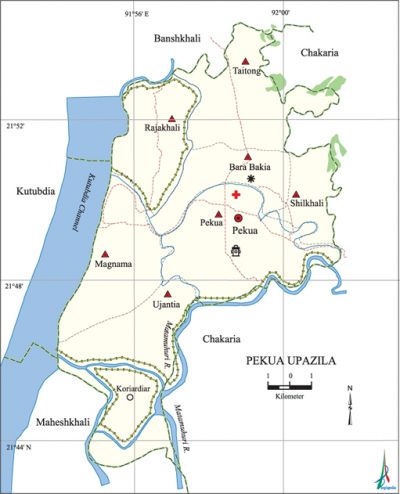Pekua Upazila
Pekua Upazila (cox’s Bazar district) area 312.47 sq km, located in between 21°43' and 21°54' north latitudes and in between 91°53' and 92°02' east longitudes. It is bounded by banshkhali and chakaria upazilas on the north, maheshkhali upazila on the south, Chakaria upazila on the east, Kutubdia Channel on the west.
Population Total 149658; male 76772; female 72886; Muslim 148080, Hindu 1432, Christian 133 and others 13. Indigenous communities such as Magh and Roai belong to this upazila.
Water bodies Kutubdia Channel and matamuhuri river are notable.
Administration Pekua upazila was formed on 23 April 2002 comprising 7 unions (Ujantia, Pekua, Taitong, Bara Bakia, Magnama, Rajakhali, Shilkhali) of Chakaria upazila.
| Upazila | ||||||||
| Municipality | Union | Mouza | Village | Population | Density (per sq km) | Literacy rate (%) | ||
| Urban | Rural | Urban | Rural | |||||
|
- |
7 |
11 |
132 |
- |
149658 |
478 |
- |
27.93 |
| Union | ||||
| Name of union and GO code | Area (acre) | Population | Literacy rate (%) | |
| Male | Female | |||
|
Ujantia 78 |
3503 |
4571 |
4237 |
38.14 |
|
Pekua 83 |
7266 |
17962 |
16566 |
28.64 |
|
Taitong 96 |
247 |
9826 |
10334 |
21.39 |
|
Bara Bakia 11 |
34410 |
13632 |
13269 |
26.55 |
|
Magnama 78 |
8872 |
14959 |
13867 |
26.50 |
|
Rajakhali 89 |
4370 |
11985 |
10855 |
20.82 |
|
Shilkhali 11 |
19450 |
3837 |
3758 |
33.52 |
Source Bangladesh Population Census 2001, Bangladesh Bureau of Statistics.

Religious institutions Mosque 253, temple 9, keyang 1.
Literacy rate and educational institutions Average literacy 27.93%; male 30.84%, female 24.92%. Educational institutions: college 1, technical college 1, secondary school 11, primary school 40, satellite school 7, community school 4, orphanage 13, madrasa 269. Noted educational institutions: Pekua GMC Institution (1938), Shilkhali High School (1968), Pekua Government Primary School (1918).
Cultural organisations Library 1, club 78, women society 55, playground 1.
Important installations' This upazila has a number of cyclone shelters.
Main sources of income Agriculture 62.01%, non-agricultural labourer 7.42%, industry 0.66%, commerce 10.18%, transport and communication 1.16%, service 4.27%, construction 0.43%, religious service 0.21%, rent and remittance 1.74% and others 11.92%.
Ownership of agricultural land Landowner 37.81%, landless 62.19%.
Main crops Paddy, potato, mustard, chilli, sugarcane, wheat, ground-nut, betel leaf, vegetables.
Main fruits Mango, jackfruit, litchi, banana, papaya, pineapple, guava, lemon.
Fisheries, dairies and poultries Fish landing station 15, dairy 3, poultry 15.
Communication facilities Pucca road 82.71 km, semi-pucca road 80 km, mud road 205 km; bridge 37, culvert 108.
Extinct or nearly extinct traditional transport Palanquin, horse carriage.
Noted manufactories Rice mill, saw mill, salt industry, fish processing industries, printing press, bakery.
Cottage industries Goldsmith, blacksmith, wood work.
Hats, bazars and fairs Hats and bazars are 17, most noted of which are Rajakhali Alek Shah Bazar and Pekua Hat.
Main exports Shrimp, salt, ground-nut, fish, betel leaf, vegetables.
Access to electricity All the unions of the upazila are under rural electrification net-work. However 7.60% of the dwelling households have access to electricity.
Sources of drinking water 'Tube-well 96.55%, tap 0.66%, pond 2.13% and others 0.66%.
Sanitation 23.85% of dwelling households of the upazila use sanitary latrines and 68.04% of dwelling households use non-sanitary latrines; 8.11% of households do not have latrine facilities.
Health centres Upazila health complex 1, satellite clinic 1, family planning centre 3, hospital 2.
Natural disasters Many people of this upazila were victims of the cyclone and tidal bore of 29 April 1991; these natural disasters also caused heavy damages to livestock and crops of the upazila. Besides, the devastating cyclone of 19 May 1997 also caused heavy damages to properties of the area.
NGO activities Operationally important NGOs are brac, asa. [Nilufa Yasmin]
References Bangladesh Population Census 2001, Bangladesh Bureau of Statistics; Cultural survey report of Pekua Upazila 2007.
